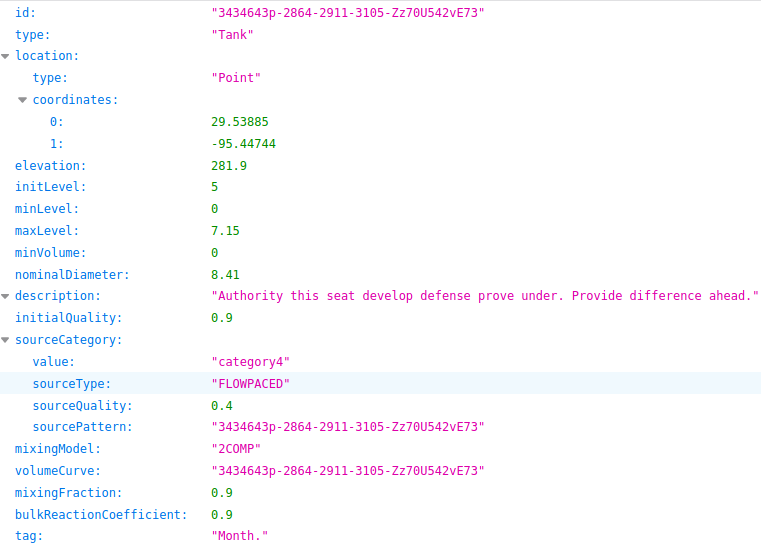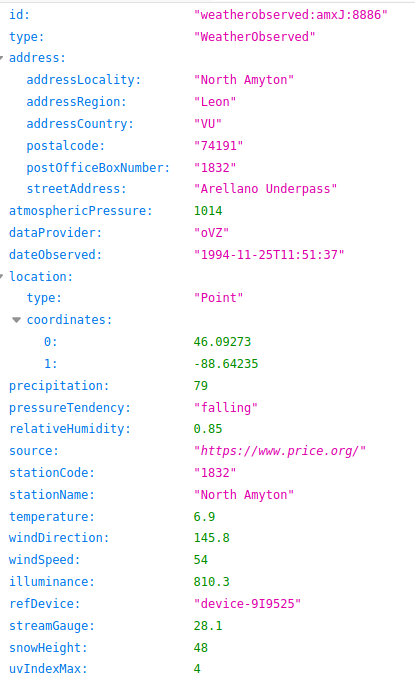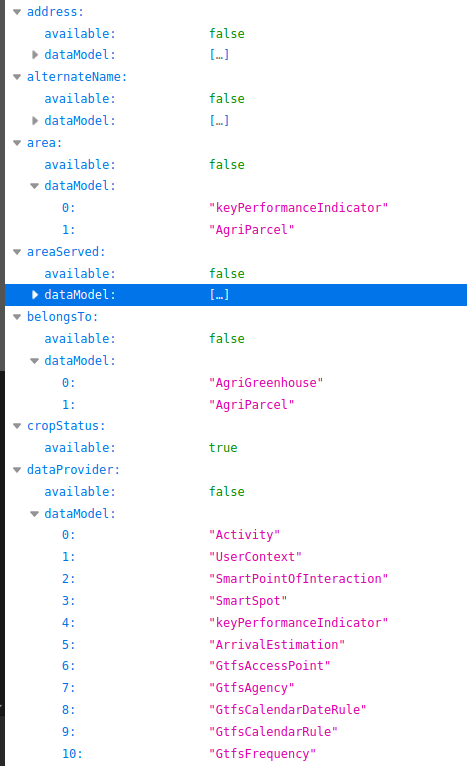It has been included the concept of vertices into the data models of Valve, Pump and Pipe, into the water networks management of the Smart Water domain.
Check the changes into the PR here.
It has been included the concept of vertices into the data models of Valve, Pump and Pipe, into the water networks management of the Smart Water domain.
Check the changes into the PR here.
There is a working group about risk assessment. They are starting to work in the incubated repository in a Risk assessment repository. Some results are expected in the coming 4 weeks.
The initial evaluation of risks will be focused on the water networks’ risks, but generaliation is expected.
Harmonization repository is dedicated to those data models that are mostly accepted and only requirements of consistency, complete documentation and examples availability.
Here there is a list of coming data models in different domains:
Battery
StorageBattery
StorageBatteryDevice
StorageBatteryMeasurement
Energy
ACMeasurement
InverterDevice
PhotoVoltaicDevice
PhotovoltaicMeasurement
Environment
ElectroMagneticObserved
PhreaticLevel
RainFallRadarObservation
Ports
BoatAtuthorized
BoatPlacesAvailable
BoatPlacesPricing
SeaportFacilities
Smart cities
CityWorks
StationDescription
We’ve submitted into the utils directory a short script for installing and running an instance of NGSI v2 and to create your first entity and to list it. It is not a complete guide which is available at FIWARE mains page in this link.
# 1.- if your are coming from a clean installation
sudo docker pull mongo:3.6
sudo docker pull fiware/orion
sudo docker network create fiware_default
sudo docker run -d –name=mongo-db –network=fiware_default –expose=27017 mongo:3.6 –bind_ip_all –smallfiles
sudo docker run -d –name fiware-orion -h orion –network=fiware_default -p 1026:1026 fiware/orion -dbhost mongo-db
# 2.- In case you already had a installation it is better to run these instructions
docker stop fiware-orion
docker rm fiware-orion
docker stop mongo-db
docker rm mongo-db
docker network rm fiware_default
# 3.- Check that your installation is up and running
curl -X GET ‘http://localhost:1026/version’
# 4.- Create your first entity
curl -iX POST ‘http://localhost:1026/v2/entities’ -H ‘Content-Type: application/json’ -d ‘
{
“id”: “urn:ngsi-ld:PhotovoltaicDevice:PhotovoltaicDevice:MNCA-PV-T2-R-012”,
“type”: “PhotovoltaicDevice”,
“name”: {
“type”: “Property”,
“value”: “DEVICE-PV-T2-R-012”
},
“alternateName”: {
“type”: “Property”,
“value”: “AirPort – global Observation”
},
“description”: {
“type”: “Property”,
“value”: “Photo-voltaic Device description”
},
“location”: {
“type”: “GeoProperty”,
“value”: {
“type”: “Point”,
“coordinates “: [43.664810, 7.196545]
}
},
“address”: {
“type”: “Property”,
“value”: {
“addressCountry”: “FR”,
“addressLocality”: “Nice”,
“streetAddress”: “Airport – Terminal 2 – Roof 2 – Local 12”
}
},
“areaServed”: {
“type”: “Property”,
“value”: “Nice Aeroport”
},
“refDevice”: {
“type”: “Relationship”,
“value”: “urn:ngsi-ld:Device:PV-T2-R-012”
},
“brandname”: {
“type”: “Property”,
“value”: “Canadian Solar”
},
“modelName”: {
“type”: “Property”,
“value”: “CS6P-270P”
},
“manufacturerName”: {
“type”: “Property”,
“value”: “Canadian Solar EMEA GmbH,”
},
“serialNumber”: {
“type”: “Property”,
“value”: [“CSPV270P-SN1804L6J34Z8742H”,
“CSPV270P-SN1804L6J34Z8743H”,
“CSPV270P-SN1804L6J34Z8744H”,
“CSPV270P-SN1804L6J34Z8745H”,
“CSPV270P-SN1804L6J34Z8746H”
]
},
“application”: {
“type”: “Property”,
“value”: “electric”
},
“cellType”: {
“type”: “Property”,
“value”: “polycrystalline”
},
“instalationMode”: {
“type”: “Property”,
“value”: “roofing”
},
“instalationCondition”: {
“type”: “Property”,
“value”: [“extremeHeat”, “extremeCold”, “extremeClimate”, “desert”]
},
“possibilityOfUsed”: {
“type”: “Property”,
“value”: “stationary”
},
“integrationMode”: {
“type”: “Property”,
“value”: “IAB”
},
“documentation”: {
“type”: “Property”,
“value”: “https://www.myDevicePV.Cn”
},
“owner”: {
“type”: “Property”,
“value”: [“Airport-Division Maintenance”]
},
“cellDimension”: {
“type”: “Property”,
“value”: {
“length”: 16.0,
“width”: 9.0,
“thickness”: 2.3
}
},
“moduleNbCells”: {
“type”: “Property”,
“value”: 60
},
“moduleDimension”: {
“type”: “Property”,
“value”: {
“length”: 1600,
“width”: 975,
“thickness”: 3.75
}
},
“panelNbModules”: {
“type”: “Property”,
“value”: 1
},
“panelDimension”: {
“type”: “Property”,
“value”: {
“length”: 1638,
“width”: 982,
“thickness”: 40
}
},
“panelWeight”: {
“type”: “Property”,
“value”: 18
},
“arealWeight”: {
“type”: “Property”,
“value”: 32
},
“maxPressureLoad”: {
“type”: “Property”,
“value”: {
“hail”: 2500,
“snow”: 5400,
“wind”: 2400
}
},
“NominalPower”: {
“type”: “Property”,
“value”: 270
},
“MaximumSystemVoltage”: {
“type”: “Property”,
“value”: 1000
},
“applicationClass”: {
“type”: “Property”,
“value”: “A”
},
“fireClass”: {
“type”: “Property”,
“value”: “C”
},
“pTCClass”: {
“type”: “Property”,
“value”: 92.1
},
“nTCClass”: {
“type”: “Property”,
“value”: 88.3
},
“protectionIP”: {
“type”: “Property”,
“value”: “IP67”
},
“moduleSTC”: {
“type”: “Property”,
“value”: {
“Pmax”: 270,
“Umpp”: 30.8,
“Impp”: 8.75,
“Uoc”: 37.9,
“Isc”: 9.32
}
},
“moduleNOCT”: {
“type”: “Property”,
“value”: {
“Pmax”: 196,
“Umpp”: 28.1,
“Impp”: 6.97,
“Uoc”: 34.8,
“Isc”: 7.55
}
},
“moduleYieldRate”: {
“type”: “Property”,
“value”: 16.79
},
“panelOperatingTemperature”: {
“type”: “Property”,
“value”: {
“min”: -40,
“max”: 85
}
},
“cellOperatingTemperature”: {
“type”: “Property”,
“value”: {
“min”: 45,
“max”: 2
}
},
“temperatureCoefficient”: {
“type”: “Property”,
“value”: {
“Pmax”: -0.41,
“Uoc”: -0.31,
“Isc”: 0.053
}
},
“performanceLowIrradiance”: {
“type”: “Property”,
“value”: 96.5
},
“panelLifetime”: {
“type”: “Property”,
“value”: 30
},
“panelYieldCurve”: {
“type”: “Property”,
“value”: [“95.0”, “92.5”, “90.0”, “87.5”, “85.0”, “80.0”]
},
“panelYieldRate”: {
“type”: “Property”,
“value”: 0.5
},
“panelTiltReference”: {
“type”: “Property”,
“value”: {
“min”: 28,
“max”: 37
}
}
}
‘
# 5.- List the entity you have created
curl -G -X GET ‘http://localhost:1026/v2/entities’ -d ‘options=keyValues’
Tank is one of the elements of a water network infrastructure. Now in this link, you can generate random examples of a Tank. Refresh the page and you’ll get several examples.

The CIM for Energy (see its users group) is a well-established reference in the Energy sector. Thanks to the collaboration with RWTH university and other entities a first draft of the specifications about the infrastructure elements is on development. Based on these python classes a PoC is being done in the incubated repository in this link.
483 elements have been ‘translated’.
We are in the way of creating a service for testing purposes for getting payloads according to a data model.
The service is under debugging, so it cannot be trusted for production purposes. Let us know issues here
In order to access it has to access this URL (https://smartdatamodels.org/extra/payload_generator.php) with these two parameters token and dataModel
I.e. with a weather observation in the link below:
https://smartdatamodels.org/extra/payload_generator.php?token=sSdme8954c9&dataModel=%22WeatherObserved (reload page several times for generation)
In the production stage, there will be necessary a token in order to, if necessary, to limit the access for a single user. Additionally, it should be available the options of normalized and keyvalues and for the NGSI v2 and LD.

We are in the way of creating a service for those contributors willing to contribute with a complete data model.
The service is under debugging, so it cannot be trusted for production purposes. Let us know issues here
In order to access it has to access this URL (https://smartdatamodels.org/extra/check_properties.php) with this parameter ?urlSchema=[url of the raw access o the JSON schema]
I.e. a complete link could be
It returns a JSON payload indicating if this property is available for use (not used in any other data model) or in the case it is already being used what data models are currently using.

Whenever there is measurement it could be necessary to use the unitCode for setting the units for the value.
Now the guidelines for the data model’s creation include the place to find out these unit codes. See section units.
The list of UN/CEFACT Common Code (3 characters) can be download from this page. Or the list directly from here.
Now, this data model AirqualityObserved can be used for indoors and outdoors measurements.
Check it out in the environment Subject.
This is the PR.
Thanks to the contributor Daniel Villalba.